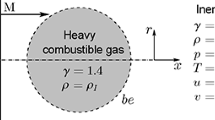Abstract
The effect of the initiation step of a reaction mechanism on direct initiation of a self-sustained detonation has been studied numerically. For this purpose, the reaction mechanism has been simulated with a three-step chemical kinetics model that consists sequentially of the chain-initiation and chain-branching steps, followed by chain termination. A characteristic time τ I is defined for each step of the mechanism, which includes effects of different kinetics parameters. It is shown that τ I is a determining factor of the minimum allowable shock pressure. It is observed that the minimum shock pressure in the decaying period of critical initiation tends to the von Neumann pressure when τ I becomes large. As a result, at large τ I , the critical initiation becomes similar to the supercritical initiation. On the other hand, the amplification mechanism of the leading shock in the decaying period depends on τ I .
Similar content being viewed by others
References
Ya. B. Zel’dovich, S. M. Kogarko, and N. N. Simonov, “Experimental study of spherical gas detonation,” Zh. Tekh. Fiz., 26, No. 8, 1744–1769 (1956).
S. M. Kogarko, V. V. Adushkin, and A. G. Lyamin, “Investigation of spherical detonation of gas mixtures,” Combust., Expl., Shock Wave, 1, No. 2, 15–23 (1965).
V. A. Levin and V. V. Markov, “Initiation of detonation by concentrated release of energy,” Combust., Expl., Shock Waves, 11, No. 4, 529–536 (1975).
G. G. Chernyi, V. P. Korobeinikov, V. A. Levin, and S. A. Medvedev, “Motion of combustible gas mixtures associated with detonation waves,” Astronaut. Acta, 15, 259–266 (1970).
C. A. Eckett, J. J. Quirk, and J. E. Shepherd, “The role of unsteadiness in direct initiation of gaseous detonation,” J. Fluid Mech., 421, 147–183 (2000).
G. J. Sharpe and A. E. G. Falle, “One-dimensional numerical simulation of idealized detonations,” Proc. Roy. Soc. London, A, 455, 1203–1214 (1999).
K. Mazaheri, “Mechanism of the onset of detonation in direct initiation,” Ph. D. Thesis, Department of Mechanical Engineering, McGill University, Canada (1997).
V. P. Korobeinikov, V. A. Levin, V. V. Markov, and G. G. Chernyi, “Propagation of blast waves in a combustible gas,” Astronaut. Acta, 17, 529–537 (1972).
J. W. Dold and A. K. Kapila, “Comparison between shock initiation of detonation using thermally-sensitive and chain branching chemical models,” Combust. Flame, 85, 194 (1991).
M. Short and J. J. Quirk, “On the nonlinear stability and detonability of a detonation wave for a model threestep chain-branching reaction,” J. Fluid Mech., 339, 89–119 (1997).
H. D. Ng and J. H. S. Lee, “Direct initiation of detonation with a multi-step reaction scheme,” J. Fluid Mech., 476, 179–211 (2003).
Z. Liang, L. Bédard-Tremblay, and L. Bauwens, “Planar detonation structure for chain-branching kinetics with large activation energy and small initiation rate,” J. Loss Prevent. Proc. Ind., 20, 570–577 (2007).
K. Mazaheri and S. A. Hashemi, “The effect of chain initiation reaction on the stability of gaseous detonations,” Combust. Sci. Technol., 179, 1701–1736 (2007).
A. Bourlioux, “Numerical studies of unstable detonations,” Ph. D. Thesis, Department of Applied and Computational Mathematics, Princeton University, USA (1991).
P. Colella and P. R. Woodward, “The piecewise parabolic method (PPM) for gas-dynamical simulations,” J. Comput. Phys., 54, 174–201 (1984).
I. L. Chern and P. Colella, “A conservative front tracking method for hyperbolic conservation laws,” Technical Report No. UCRL 97200, Lawrence Livermore National Laboratory (1987).
M. J. Berger and P. Colella, “Local adaptive mesh refinement for shock hydrodynamics,” J. Comput. Phys., 82, 64–84 (1989).
G. Taylor, “The dynamics of the combustion products behind plane and spherical detonation fronts in explosives,” in: Proc. Roy. Soc. London, A, 200, 235–247 (1950).
R. Knystautas, “An experimental study of spherical gaseous detonation waves,” Ph. D. Thesis, Department of Mechanical Engineering, McGill University, Canada (1968).
Author information
Authors and Affiliations
Corresponding author
Additional information
__________
Translated from Fizika Goreniya i Vzryva, Vol. 46, No. 3, pp. 95–102, May–June, 2010.
Rights and permissions
About this article
Cite this article
Hashemi, S.A., Fattahi, A. Effect of the chain initiation reaction rate on direct initiation of detonation. Combust Explos Shock Waves 46, 325–331 (2010). https://doi.org/10.1007/s10573-010-0045-1
Received:
Revised:
Published:
Issue Date:
DOI: https://doi.org/10.1007/s10573-010-0045-1




